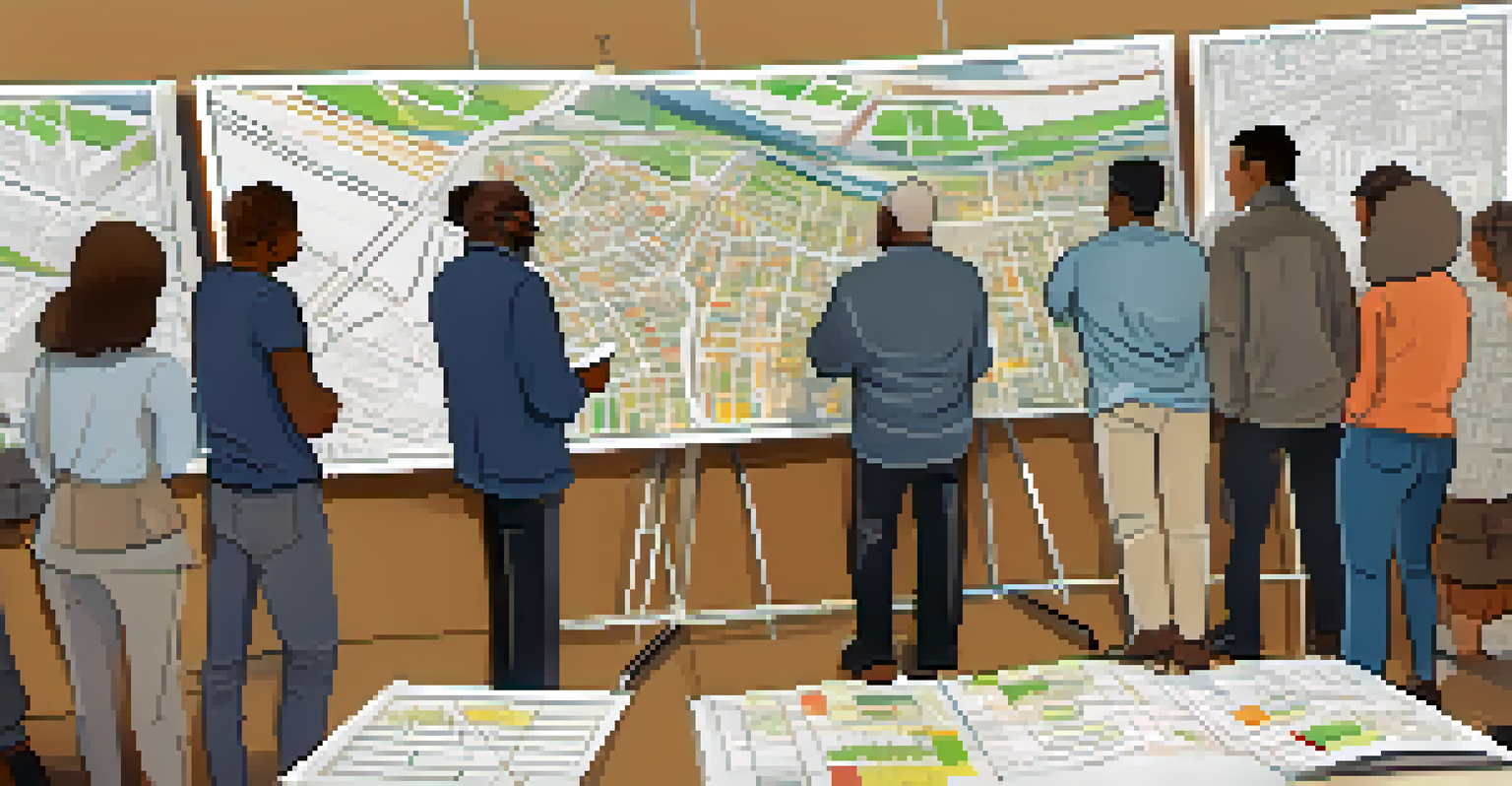Impact of Climate Change on Urban Transportation Planning

Understanding the Link Between Climate Change and Urban Transport
Climate change is not just a global issue; it has local implications, especially for urban transportation. As cities expand, the strain on transport networks increases, and climate-related events—like flooding or heatwaves—can disrupt these systems. The interconnectedness of climate and transportation means that any changes in climate can directly affect how we move within urban spaces. Therefore, understanding this relationship is crucial for effective urban planning.
Climate change is a challenge that requires a response from all sectors, including transportation, which is a key contributor to greenhouse gas emissions.
For instance, consider a city that relies heavily on buses. If rising temperatures lead to more frequent heatwaves, the efficiency of bus services may decline as infrastructure deteriorates. Additionally, increased flooding can cause road closures, leading to longer commute times and frustrated commuters. This illustrates how climate change can ripple through urban transport systems, necessitating a proactive planning approach.
By acknowledging climate change's impact, urban planners can develop more resilient transportation systems. This might include creating more robust infrastructure or diversifying transportation options to reduce reliance on any single mode. Ultimately, the goal is to ensure that urban transport remains functional and efficient, regardless of climate challenges.
The Role of Sustainable Transport in Mitigating Climate Effects
Sustainable transport options, such as cycling, walking, and public transit, play a vital role in reducing a city's carbon footprint. By promoting these alternatives, urban planners can help minimize greenhouse gas emissions, contributing to the fight against climate change. When cities invest in bike lanes and pedestrian-friendly spaces, they not only enhance mobility but also foster a healthier environment.

For example, cities like Amsterdam have successfully integrated cycling into their transport networks, leading to lower emissions and reduced traffic congestion. Such initiatives show that sustainable transport isn't merely an alternative; it can be a primary strategy for urban mobility. By prioritizing these options, cities can adapt to climate realities while improving residents' quality of life.
Climate Change Affects Urban Transport
The impact of climate change disrupts urban transportation networks, necessitating proactive planning to ensure functionality.
Furthermore, embracing sustainable transport can lead to economic benefits. Reduced reliance on fossil fuels can cut costs for both individuals and municipalities. When urban areas prioritize green transport solutions, they create a more resilient infrastructure that can withstand climatic shifts.
Adapting Infrastructure to Climate Change Challenges
Urban infrastructure must evolve in response to the challenges posed by climate change. This involves updating existing transport networks to withstand extreme weather events and integrating climate resilience into new projects. For instance, elevating roadways in flood-prone areas or using materials that can endure higher temperatures are practical adaptations that cities can implement.
Sustainable transport is not just about moving people; it's about creating a better quality of life and a healthier environment.
Moreover, cities can incorporate green infrastructure, such as rain gardens and permeable pavements, to manage stormwater and reduce urban heat. These features not only enhance the transport network's resilience but also contribute to improved urban ecosystems. For example, a city that integrates green spaces within its transport plan not only prepares for climate impacts but also beautifies the urban landscape.
In essence, adaptive infrastructure helps ensure that urban transport systems remain reliable and functional in the face of climate challenges. By investing in such improvements, cities can safeguard their transportation networks and enhance the overall resilience of their urban environments.
The Importance of Data-Driven Decision Making
In the age of technology, data plays a crucial role in urban transportation planning, especially concerning climate change. By leveraging data analytics, cities can identify patterns, predict potential climate impacts, and make informed decisions about transport infrastructure and services. This approach allows for a more proactive rather than reactive management of urban transport systems.
For example, cities can use historical climate data to forecast future conditions and adjust transport plans accordingly. This might involve rerouting public transport during predicted severe weather events or enhancing maintenance schedules for vulnerable infrastructure. Such data-driven strategies ensure that urban planners are equipped with the necessary insights to navigate the complexities of climate change.
Sustainable Transport Reduces Emissions
Investing in sustainable transport options like cycling and public transit helps cities lower their carbon footprints and enhance mobility.
Ultimately, adopting a data-centric approach leads to smarter, more resilient urban transportation systems. By embracing technology and analytics, cities can better prepare for the unpredictable effects of climate change, creating a sustainable future for urban mobility.
Engaging Communities in Transportation Planning
Community engagement is a vital aspect of effective urban transportation planning, particularly in the context of climate change. When residents are involved in the planning process, their unique insights and experiences can help shape more resilient transport systems. Engaging communities fosters a sense of ownership and responsibility, encouraging individuals to embrace sustainable transport options.
For instance, hosting public forums or workshops can provide a platform for residents to voice their concerns and suggest improvements. By actively listening to the community's needs, planners can create transportation solutions that not only address climate challenges but also resonate with the people who use them daily. This collaborative approach can lead to innovative ideas that may not surface in traditional planning methods.
Moreover, community involvement can enhance public support for transportation initiatives aimed at climate adaptation. When individuals see their contributions reflected in transport plans, they are more likely to advocate for and adopt sustainable practices. In essence, engaging communities is essential for building a resilient urban transportation framework that aligns with the realities of climate change.
Policy Frameworks Supporting Climate-Resilient Transport
Robust policy frameworks are essential for guiding urban transportation planning in the face of climate change. These policies should prioritize sustainability, resilience, and accessibility, ensuring that transport systems can adapt to evolving climate conditions. By establishing clear guidelines, cities can create a cohesive approach that integrates climate considerations into all aspects of transportation planning.
For instance, policies that promote investment in public transit and active transportation infrastructure can reduce reliance on private vehicles, thereby lowering emissions. Additionally, incorporating climate resilience into zoning and land-use policies can help mitigate the impacts of climate change on transport networks. Such comprehensive strategies lay the groundwork for a more sustainable urban future.
Community Engagement Drives Solutions
Involving communities in transportation planning fosters ownership and leads to innovative, resilient transport systems that address climate challenges.
Furthermore, collaboration among various stakeholders—government agencies, private sectors, and community organizations—is crucial for effective policy implementation. By working together, these entities can ensure that transportation initiatives align with broader climate goals. Ultimately, a well-structured policy framework fosters a proactive approach to urban transportation planning, equipping cities to tackle the challenges posed by climate change.
Future Trends Shaping Urban Transportation Amid Climate Change
As we look ahead, several trends are emerging that will shape urban transportation in the context of climate change. Innovations in technology, such as electric vehicles (EVs) and smart traffic management systems, hold the potential to revolutionize how we navigate our cities. By embracing these advancements, urban planners can create more sustainable and efficient transport solutions.
Additionally, the rise of shared mobility services, like ride-sharing and bike-sharing, presents new opportunities for reducing traffic congestion and emissions. These services allow cities to optimize their transport networks while providing residents with flexible commuting options. As more people adopt shared mobility, the demand for individual car ownership may decline, further easing the strain on urban transport systems.

Moreover, incorporating climate resilience into future transport designs will become increasingly important. As cities face growing climate challenges, the focus will shift toward creating transport systems that can withstand extreme weather events. By anticipating future needs and trends, urban planners can build more adaptable and sustainable transportation networks that benefit both the environment and the community.